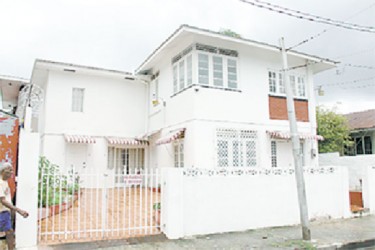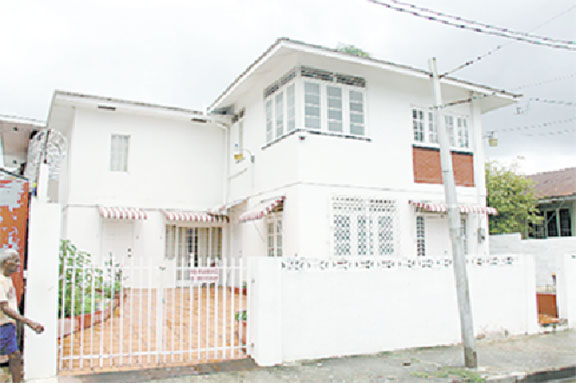(Trinidad Guardian) – The family home of Trinidad-born novelist VS Naipaul, known as the model for the eponymous house in Naipaul’s 1963 novel A House for Mr Biswas, will be opened to the public as a literary museum in October.

Professor Kenneth Ramchand, chairman of the group Friends of Mr Biswas, gave the T&T Guardian the date during a tour of the house at 26 Nepaul Street, St James last week.
The group was incorporated by an act of Parliament in 2000 to manage and develop the house. In 2006, the Government granted them a 99-year lease of the property, Ramchand said. The Friends of Mr Biswas lobbied for funding from governments from the time of its inception and began “extensive renovation works” in 2008. Asked why it took so long to reach this point, Ramchand said: “Everything went slowly because it was quite a handful to renovate the building.
“The money started to come in 2008 in tranches and therefore we had to do the work in tranches.” He said underground water which seeped into the structure and a termite problem caused additional delays. But by the end of 2010, most of the renovation work was complete. The total cost of renovation was about $700,000 he said, and was provided by several government ministries. “We could have done more in the last two years, but funding, committee membership and logistics caused problems.”
Ramchand said the group needed about $500,000 to complete work for the October opening. Once the literary museum is established, revenue will be generated through rental of the apartments on the site, membership fees and special events. These funds, Ramchand said, would hopefully make the group self-sufficient. There will be at least three staff members at the museum: a librarian, an office manager and a handyman.
Other executive members of the group are Ashvin Rai Akal, son of Naipaul’s sister Savitri Akal; Rajendra Ramlogan, a lawyer; historian Dr Radhica Mahase; and Lenore Dorset, former protocol officer in the office of the President.
What Naipaul wrote:
“On the ground floor of Mr Biswas’s two-storey house the solicitor’s clerk had put a tiny kitchen in one corner; the remaining L-shaped space, unbroken, served as drawing room and dining room.” “Upstairs, just above the kitchen, the clerk had constructed a concrete room which contained a toilet bowl, a wash-basin and a shower….The remaining L-shaped space was broken up into a bedroom, a verandah, a bedroom.”
“….They saw the polished floor, the rich curtains, the celotex ceiling, the morris suite, and they wanted to see little more.” —From A House for Mr Biswas
‘A shame’ – sister
Savitri Akal, sister of VS Naipaul, is less than thrilled by what has happened to her family home since it was sold to the Government after their mother’s death in 1991. “It’s a shame,” she said of the 20 years of neglect. Saying she spoke only on her own behalf and not for the rest of her family, she said: “I am very angry and very disappointed. We feel if we took the house back from the Government we will probably be able to run it and keep it much better than they have done.”
Having been told by the Government the house would be used as a museum, the family sold the house to the State for a little over $300,000. “It’s been a very long time and very little has been done by the Government,” Akal said in an interview with the T&T Guardian. “You don’t buy a property and say you are using it for something and 20 years later it has not yet been done.”
In response to the recent announcement that the house would be opened this year as a museum, Akal said: “I will have to see whether that happens.” Asked if she would donate any memorabilia from the original house to the museum, she said she was very apprehensive. “I won’t give it. I don’t have any faith that the things I have will be kept in order.”
She said she would not give anything until she were absolutely sure it would be taken care of. Asked if she blamed only the Government for the neglect of the house, Akal said: “It’s more than the Government. I blame, in a way, the culture of our society, and what we consider important and not important.” Referring to the condition of the President’s House and the Magnificent Seven, she said the neglect of the country’s historic buildings showed a lack of pride on the part of the Government and the owners.
A tour of the house
Seepersad Naipaul, VS Naipaul’s father and a reporter at the Trinidad Guardian, bought the house on December 5, 1946. “He is the Biswas in the book. He is the man who is fighting to get his own house to put his family and to escape his in-laws,” Ramchand said.
Today, the main structure of the house still fits the description in Naipaul’s 1963 novel: “The house could be seen from two or three streets away and was known all over St James.
It was like a huge and squat sentry-box: tall, square, two-storeyed, with a pyramidal roof of corrugated iron.” A two-storey annex behind the house on the northern side and a flat, plain galvanised roof are the obvious changes.
With its red and white awnings, frosted-glass casement windows and white latticework, the chalk-white house is the second building on the left below the Western Main Road. A three-foot-high wall, interrupted by a BRC front gate and a gated driveway, borders the street. The front gate opens into a clay-tiled pathway which leads to the front door.
Ramchand said the layout of the ground floor, as depicted in the 1963 novel, had been maintained. An administrative area and two computer workstations for the purpose of literary study will occupy the front corner adjacent to the kitchen. Currently an empty space with an oak-patterned floor, the remaining half will form the museum after being restored to its mid-twentieth-century appearance, as described in Naipaul’s novel.
The table on which the younger children (Vidia was the eldest of six) did their homework will be rented from the Naipauls and added to the museum. “The yellow typewriter that Mr Biswas had in the novel actually exists and will be in the museum,” Ramchand said. The other possessions mentioned in the book—the hatrack, book case, dining table and glass case—will be reconstructed to match the original items, with the help of the Naipaul family, he said.
The layout of the first floor, as outlined in the novel, has also been maintained. One of the bedrooms, already filled with a Morris suite and bookcases with glass doors, will be converted into a library, containing books by the Naipauls—Seepersad, Sir Vidia, and his younger brother Shiva—and other major works by Trinidadian writers.
The family merged the verandah and the other bedroom into one bedroom, Ramchand said. A four-poster bed, similar to the one Seepersad used, will be placed in this room, which will be known as Seepersad’s room. Two apartments, filled with furniture consistent with the original house, make up the two-storey annex. Ideally, the apartments will be rented to writers and visiting literary scholars and function as a revenue-earner.
Seepersad Naipaul lived in the house until his death in 1953. His widow Droapatie occupied the house for more than 40 years after his death. “That she didn’t run back to her family as a widow after he died was his achievement too,” Ramchand said. “She maintained the independence of the family by keeping up the house.” That, he explained, is why the sign which will be put up on the house will read: “The Biswas House: Family home of Seepersad and Droapatie Naipaul.”

